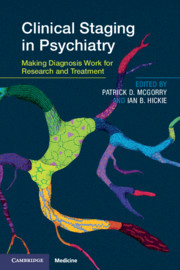Book contents
- Clinical Staging in Psychiatry
- Clinical Staging in Psychiatry
- Copyright page
- Contents
- Contributors
- Foreword
- Acknowledgements
- Section 1 Conceptual and Strategic Issues
- Section 2 Progress with Clinical Staging
- Section 3 Novel Treatment Strategies
- Section 4 Novel Treatment Strategies
- Index
- Plate Section (PDF Only)
- References
Section 4 - Novel Treatment Strategies
Published online by Cambridge University Press: 08 August 2019
- Clinical Staging in Psychiatry
- Clinical Staging in Psychiatry
- Copyright page
- Contents
- Contributors
- Foreword
- Acknowledgements
- Section 1 Conceptual and Strategic Issues
- Section 2 Progress with Clinical Staging
- Section 3 Novel Treatment Strategies
- Section 4 Novel Treatment Strategies
- Index
- Plate Section (PDF Only)
- References
Summary
Although mental health issues are the key health concern for young people, contributing 45% of the total burden of disease for those aged 10-24 years, young people have the poorest access to mental health care. Current service approaches are insufficient, poorly designed and not well supported. Transformational reform of mental health care is needed, based on principles of evidence-informed care, early intervention, and a focus on the developmental period of greatest need and capacity to benefit from investment: emerging adulthood. The most appropriate care models for this period place emphasis on offering care that is appropriate to early stages of illness, pre-emptive in nature, and with a strong preventive focus. This sits best with a clinical staging approach, which distinguishes earlier and milder clinical phenomena from those that accompany illness progression and chronicity. This provides a clinically useful framework that is sensitive to risk/benefit considerations and facilitates the selection of earlier, safer interventions, and favours a preventive or pre-emptive treatment approach. In this chapter, rapidly emerging examples of modern, stigma-free cultures of care designed and operated with young people themselves are described. This includes headspace and technologically enhanced service delivery models. Future directions for youth services are also described.
Keywords
- Type
- Chapter
- Information
- Clinical Staging in PsychiatryMaking Diagnosis Work for Research and Treatment, pp. 261 - 283Publisher: Cambridge University PressPrint publication year: 2019



